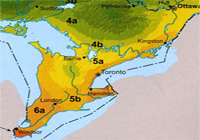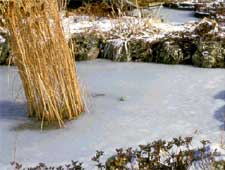
Hardy plants are perennials and can be kept for many years. Some varieties may require extra protection due to differences in your zone and actual microclimate of your pond.
Plant Hardiness Zones for many areas in Ontario are shown to the left.
For more information on Hardiness Zones visit the Agriculture and Agri-Food Canada website at:
http://sis.agr.gc.ca/cansis/nsdb/climate/hardiness/intro.html (dead link)
Hardy Water Lilies and Lotus
Hardy water lilies and lotus will overwinter if their roots do not freeze solid. Foliage will die back mid to late fall but roots will remain alive. Steps to overwinter lilies should be taken at this time. DO NOT COVER the pond or bring plants inside until late fall when dormancy has begun.
Methods:
A. Move containers to the deepest area of the pond. Remove dead leaves on lilies but not on lotus. It is recommended that your pond be at least 2 1/2′ to 3′ deep in one area if this method is chosen. Colder zones in Canada should increase this depth. You may cover pond with boards or framed plastic to provide extra insulation. Do not make airtight. Return containers to original positions in spring.
OR
B. Use this method if your pond is shallow and will likely freeze solid. Remove the old leaves from the lily and bring planted containers indoors to cold storage, approximately 40°F (5°C), for the winter. Keep containers moist and dark at all times. More lilies are lost from drying out than from freezing. Return plants to the pond after the ice has melted the following spring.
NOTE: Northern sections of Canada should bring plants indoors or use a pond heater just to be safe.
Hardy Shallow Water Plants
Some hardy shallow water plants can tolerate being frozen solid while others need their roots or tubers to remain in the water. Irises, Rushes (except Pickerel Rush), Sweet Flag, Cattails, Horsetail, Marsh Marigold, Bulrush, Houttuynia, Golden Creeping Jenny and Buttercup, Watercress and Water Forget-Me-Not may be left in shallow water where they will likely freeze. Most other varieties should be moved to deep water or brought indoors to cold storage. (See method B above.) Return all plants to growing shelves as soon as the ice has melted in the spring.
NOTE: Do not remove dead leaf stocks from emergent plants such as cattail and rushes until spring. This will allow the root system to “breathe” during the winter.

May be grown outdoors during the summer, but are considered annuals unless heated greenhouse facilities are available.
Tropical Water Lilies
When brought indoors, tropical water lilies and plants continue to grow during the winter months and must receive sunlight and heat. Growth slows considerably in December and January when there is very little sunlight and the leaves will become yellow and small. Most people treat tropical water lilies as annuals due to the considerable effort required for their continual growth.
Method: Before the first heavy frost in your area, bring the tropical lily indoors to a heated greenhouse or sunroom. Place the containers in a tank, fertilize sparingly and ensure water temperature will not fall below 21°C (70°F). This will prevent the lily from going into a dormant state even though growth slows considerably. The following spring when the pond water temperature has warmed to a consistent 21°C (70°F), in early June, place the lily back in your pond.
Tropical Shallow Water Plants
Like tropical water lilies, shallow water plants must continue to grow during the winter months. Growth will be reduced considerably as daylight hours diminish. Umbrella Palm, Dwarf Papyrus, Little Giant Papyrus and White Arum lilies will survive the winter indoors and make excellent houseplants. Other varieties are best treated as annuals.
Method: Remove tropical plants from the pond before the first severe frost and bring indoors to a heated greenhouse or sunroom. Plants must remain in water and be kept at a temperature of approximately 18°C (65°F). Remove old growth if it yellows. Return to the pond in spring when there is no risk of frost.
NOTE: Small amounts of fertilizer may be required to encourage plants to keep growing during the winter.
Many people treat Tropical Shallow Water Plants and Water Hyacinths as annuals due to the cost and effort required to overwinter. Simply compost plants in the fall and restock the pond the following spring.
Water gardeners in Canada frequently use the previous overwintering methods for plants. These suggestions can be used alone or in any combination to best suit your own situation. There is no guarantee that your plants will survive the winter. By trying these commonly used methods your chances of success will be increased. We would be glad to hear from you if you have found other successful ways to winterize your plants.





